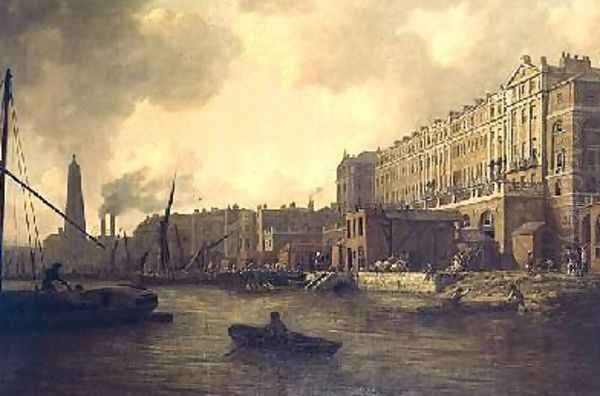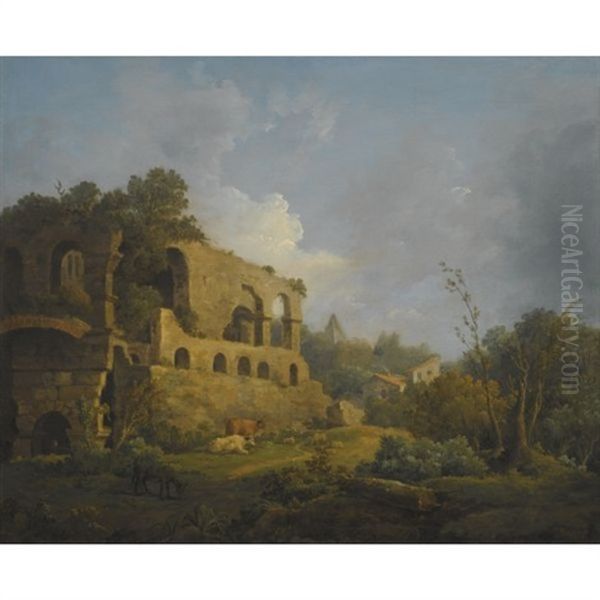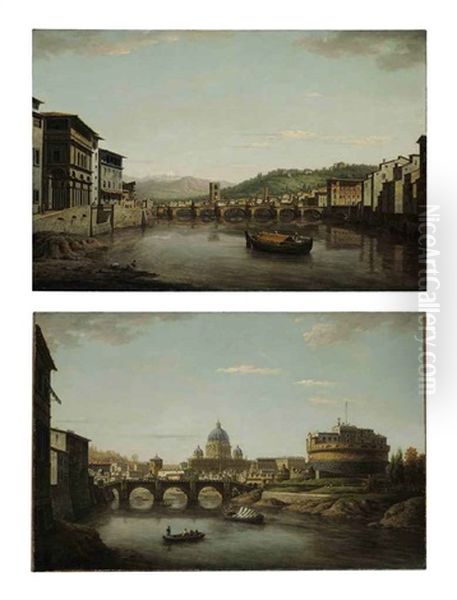William Marlow stands as a significant figure in the landscape of 18th-century British art. Born in 1740 and passing away in 1813, his life spanned a crucial period of development in British painting, particularly in the genres of landscape and marine art. Marlow carved a distinct niche for himself, becoming renowned for his evocative depictions of both British scenery, especially the River Thames, and sun-drenched Italian vistas captured during his travels. Working proficiently in both oil and watercolour, he combined topographical accuracy with a sensitive handling of light and atmosphere, leaving behind a body of work that offers valuable insights into the artistic tastes and topographical realities of his time.
Early Life and Artistic Formation
William Marlow's origins trace back to London, likely Southwark, where he was born in 1740. His artistic journey began formally under the tutelage of the respected marine painter Samuel Scott (c. 1702–1772). Scott was himself a leading painter of Thames views and naval scenes, often drawing comparisons to the Venetian master Canaletto for his detailed depictions of London's riverfront. Marlow spent approximately five years, from around 1754 to 1759, in Scott's studio, likely located in Covent Garden at the time. This apprenticeship proved foundational, instilling in Marlow a meticulous approach to observation and a deep familiarity with the bustling life and architectural landmarks along the Thames.
During his formative years, Marlow also benefited from the stimulating environment of the St Martin's Lane Academy. This was not a formal institution in the modern sense but rather an important association of artists and designers, providing opportunities for life drawing and professional exchange. It was a crucible of artistic talent in mid-18th century London, frequented by figures who would shape the course of British art. Studying here allowed Marlow to hone his skills further and likely brought him into contact with other aspiring and established artists, broadening his horizons beyond the marine focus of Scott's studio.
Influence of the Venetian Masters

The shadow of Giovanni Antonio Canal, known as Canaletto (1697–1768), loomed large over view painting in 18th-century Britain. Canaletto had spent a significant period working in London (1746-1755/56), popularizing the genre of the veduta (view painting) among British patrons. His crisp, detailed, and light-filled depictions of Venice, and later London, set a standard for topographical painting. Samuel Scott himself adapted Canaletto's style for his Thames views. Consequently, Marlow absorbed this influence, likely both directly through seeing Canaletto's works and indirectly through Scott's interpretations. This is evident in Marlow's clarity of composition, attention to architectural detail, and his skilled rendering of light and water, particularly in his earlier works.
While Canaletto's influence provided a model for precision and clarity, Marlow would develop his own distinct artistic personality, often imbuing his scenes with a softer atmosphere or a more dramatic sensibility than the Venetian master typically employed. Nonetheless, the grounding in detailed observation and structured composition derived from the Canaletto tradition remained a hallmark of his work throughout his career.
Early Career and the Society of Artists
By the early 1760s, Marlow was beginning to establish himself as an independent artist. He became actively involved with the Incorporated Society of Artists of Great Britain (ISA), a significant exhibiting body formed by artists seeking greater control over the display and sale of their work, predating the foundation of the Royal Academy. Marlow exhibited with the Society at their Spring Gardens venue between 1762 and 1674. This participation was crucial for a young artist, providing public visibility and opportunities for patronage. His contributions during these years likely included views of London and the surrounding countryside, building upon the skills acquired under Scott.
His association with the Society proved lasting. He would later become a Fellow of the Incorporated Society of Artists in 1771, indicating his respected standing among his peers. Some sources also suggest he served as Vice President of the Society in 1778, highlighting his commitment to the organization and his prominence within the London art world of the time. This involvement placed him at the heart of the professional artistic community.
The Grand Tour: Italy and France
A pivotal moment in Marlow's career came between 1765 and 1768 (some sources suggest 1767-68). Following the advice, and likely with the support, of Elizabeth Percy, Duchess of Northumberland, a notable patron of the arts, Marlow embarked on a Grand Tour of France and Italy. This journey was a rite of passage for many artists and gentlemen of the era, offering exposure to classical antiquity, Renaissance masterpieces, and the inspiring landscapes of the Continent. Marlow travelled through France, spending time in various locations, before proceeding to Italy.

His Italian sojourn was particularly fruitful. He visited Rome, Florence, and spent a considerable period in Naples. Italy offered a dramatically different visual experience compared to Britain: the intense Mediterranean light, the picturesque ruins of antiquity, dramatic coastlines, and iconic cityscapes like Venice. Marlow diligently sketched and absorbed these new sights. This experience profoundly impacted his art, expanding his subject matter and refining his handling of light and colour. He produced numerous drawings and studies in situ, which would serve as the basis for finished oil paintings and watercolours upon his return to England.
Capturing Italian Light and Landscape
The works resulting from Marlow's Italian travels became highly sought after by British patrons, many of whom had undertaken the Grand Tour themselves and desired sophisticated souvenirs of their experiences. He painted views of classical ruins in Rome, serene scenes along the Italian coast, and bustling depictions of Naples and its bay. A particularly dramatic subject that captured his imagination was Mount Vesuvius, which he depicted erupting by night in a powerful painting dated 1768. This work showcases his ability to handle dramatic light effects and tap into the burgeoning taste for the Sublime – the awe-inspiring and sometimes terrifying beauty of nature.
His Italian views often display a warmer palette and stronger contrasts of light and shadow compared to his British scenes, reflecting the different quality of Mediterranean light. While still detailed, these works sometimes possess a more idealized or picturesque quality, influenced perhaps by the classical landscape tradition of artists like Claude Lorrain (1600–1682), whose works were highly admired in Britain. Marlow successfully translated the allure of Italy for a British audience, cementing his reputation as a versatile landscape painter. He continued to paint Italian subjects throughout his career, drawing upon the sketches and memories from his tour.
Return to England: London and the Thames
Upon returning from the Continent around 1768, Marlow established himself in London, taking up residence in Leicester Square, then a fashionable area popular with artists. He resumed exhibiting regularly, showcasing both his new Italian repertoire and continuing his focus on British subjects. His depictions of London and, particularly, the River Thames became a cornerstone of his output and remain among his most celebrated works.

Marlow captured the Thames at various points along its course, from the bustling Pool of London with its ships and wharves, past the grand architecture of Westminster and Somerset House, to the more tranquil stretches upstream at Richmond and Twickenham. His paintings are valuable topographical records, documenting the appearance of the river and its banks in the latter half of the 18th century. He rendered the specific architecture, the varied river craft, and the atmospheric conditions with considerable skill. Works like View of the Adelphi from the River Thames or scenes near London Bridge demonstrate his mastery in combining detailed observation with pleasing compositions.
Contrasting Light: Britain vs. Italy
One of the fascinating aspects of Marlow's oeuvre is the comparison between his British and Italian scenes. His British landscapes, especially those of the Thames, are often characterized by a cooler, more diffused light – the silvery light typical of the English climate. Reflections on the water are rendered with subtle gradations of tone. The overall mood is often one of calm and order, even when depicting busy river traffic.
In contrast, his Italian views, as mentioned, frequently employ a warmer palette and stronger chiaroscuro (contrast of light and dark). The sunlight feels more intense, casting sharp shadows and illuminating buildings with a golden glow. This sensitivity to the different qualities of light in varying geographical locations demonstrates Marlow's keen observational skills and his ability to adapt his technique to suit the subject matter. This duality became a signature of his artistic practice.
Country Houses and Rural Scenery
Beyond the Thames and Italy, Marlow also painted views of English country houses and estates, often on commission from their owners. These works fit into a long tradition of topographical estate portraiture but were executed with Marlow's characteristic clarity and attention to atmospheric effect. He depicted well-known locations such as Strawberry Hill, the gothic fantasy home of Horace Walpole, and various scenes in the picturesque surroundings of Richmond and Twickenham, where he would eventually settle.
He also produced more generalized views of the English countryside, capturing the gentle hills, wooded areas, and meandering rivers that characterized the landscape accessible from London. These works, while perhaps less dramatic than his Italian scenes or his dynamic Thames views, showcase his appreciation for the native scenery and contributed to the growing popularity of British landscape painting as a genre in its own right, moving beyond purely topographical record.
Artistic Style: Precision and Atmosphere
William Marlow's style can be characterized as a blend of topographical accuracy inherited from the veduta tradition (Scott, Canaletto) and a sensitivity to atmosphere and light that aligns him with the developing sensibilities of British landscape painting, exemplified by artists like Richard Wilson (1713/14–1782). Wilson, often called the father of British landscape painting, favoured more idealized, classically inspired compositions based on Italian scenery but adapted to a British context. Marlow certainly knew Wilson's work and seems to have absorbed some of his feeling for balanced composition and evocative mood, though Marlow generally retained a greater degree of specific topographical detail.
His oil paintings are typically characterized by a smooth finish, careful drawing, and a clear, luminous quality. His handling of water, with its complex reflections and sense of movement, is particularly adept. In watercolour, he often employed a traditional technique, starting with a monochrome underpainting (usually in grey or neutral tints) to establish the tonal structure, followed by the application of local colour washes. His draughtsmanship was consistently strong, underpinning the structure of his compositions. He was also a capable etcher, translating some of his popular views into print form.
Professional Life: Exhibitions and Recognition
Marlow enjoyed considerable success during his main working years. After his return from Italy, he exhibited frequently not only with the Incorporated Society of Artists but also, from 1788 onwards, with the prestigious Royal Academy of Arts (founded in 1768). He continued to show works at the RA almost annually until 1796, and then once more in 1807 with a view of Twickenham. His patrons included members of the aristocracy and the growing merchant class who appreciated his refined and accessible views of both familiar British locations and exotic foreign scenes.
His circle of acquaintances likely included many prominent figures in the London art world. Besides his teacher Samuel Scott and the influential Richard Wilson, he was friendly during his training with the animal painter Sawrey Gilpin (1733–1807). He would also have known major figures like Sir Joshua Reynolds (1723–1792), the first President of the Royal Academy, and Thomas Gainsborough (1727–1788), who, though primarily a portraitist, was also a passionate and innovative landscape painter. Marlow operated within this vibrant milieu, contributing his own distinct vision. His work can be seen in dialogue with other landscape and marine specialists of the time, such as Paul Sandby (1731–1809), known for his pioneering work in watercolour and topography, or marine painters like Charles Brooking (1723–1759) and Peter Monamy (1681–1749) who preceded him but established the tradition Scott worked in.
Later Years and Legacy
Around 1785, having achieved financial security through his art, Marlow moved from London to Twickenham, a fashionable riverside village popular with artists and writers. He continued to paint, though perhaps less prolifically, and exhibited less frequently after the mid-1790s. He passed away in Twickenham on January 14, 1813, at the age of 72.
William Marlow occupies an important place in the history of British art. He was a key figure in the development of landscape and marine painting in the 18th century, successfully bridging the gap between the precise topographical tradition of Canaletto and Scott, and the more atmospheric and sometimes idealized approaches of Wilson and later Romantic painters. His work provided a popular and accomplished vision of both Britain and Italy for his contemporaries.
While perhaps overshadowed in the long run by the revolutionary genius of later landscape painters like J.M.W. Turner (1775–1851) and John Constable (1776–1837), or even contemporaries like Gainsborough or Wilson, Marlow's contribution remains significant. His paintings, particularly his Thames views, are invaluable historical documents as well as aesthetically pleasing works of art. They capture a specific moment in the visual history of London and the English landscape with clarity, skill, and a refined sensibility. His works are held in major public collections, including Tate Britain, the National Maritime Museum, the Courtauld Gallery in London, the Yale Center for British Art, and numerous regional museums in the UK, ensuring his enduring visibility and recognition as a master of 18th-century British view painting. His influence can be seen in the work of subsequent painters who tackled similar topographical or marine subjects.